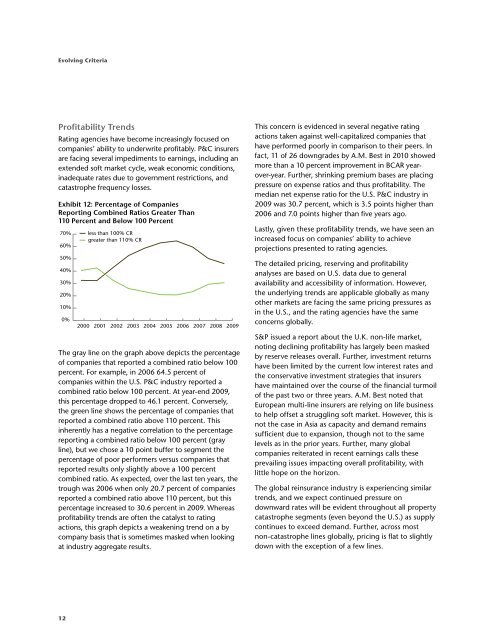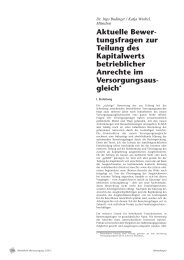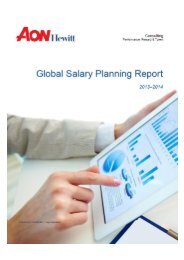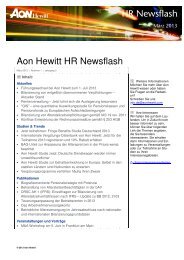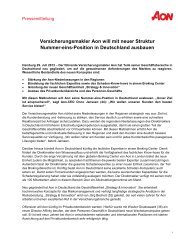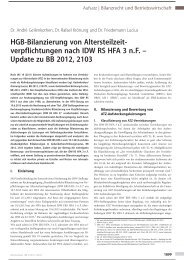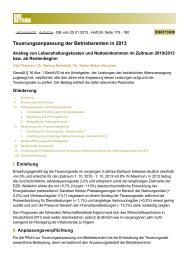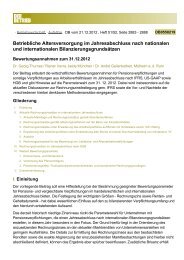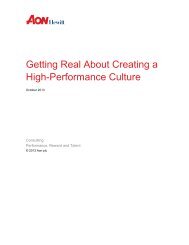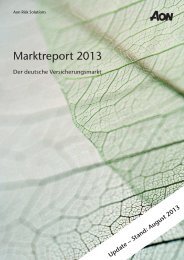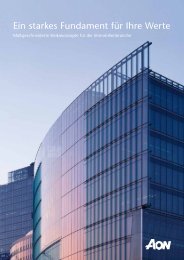Evolving Criteria - Reinsurance Thought Leadership | Aon Benfield
Evolving Criteria - Reinsurance Thought Leadership | Aon Benfield
Evolving Criteria - Reinsurance Thought Leadership | Aon Benfield
Create successful ePaper yourself
Turn your PDF publications into a flip-book with our unique Google optimized e-Paper software.
<strong>Evolving</strong> <strong>Criteria</strong><br />
Profitability Trends<br />
Rating agencies have become increasingly focused on<br />
companies’ ability to underwrite profitably. P&C insurers<br />
are facing several impediments to earnings, including an<br />
extended soft market cycle, weak economic conditions,<br />
inadequate rates due to government restrictions, and<br />
catastrophe frequency losses.<br />
Exhibit 12: Percentage of Companies<br />
Reporting Combined Ratios Greater Than<br />
110 Percent and Below 100 Percent<br />
70%<br />
60%<br />
50%<br />
40%<br />
30%<br />
20%<br />
10%<br />
0%<br />
12<br />
less than 100% CR<br />
greater than 110% CR<br />
2000 2001 2002 2003 2004 2005 2006 2007 2008 2009<br />
The gray line on the graph above depicts the percentage<br />
of companies that reported a combined ratio below 100<br />
percent. For example, in 2006 64.5 percent of<br />
companies within the U.S. P&C industry reported a<br />
combined ratio below 100 percent. At year-end 2009,<br />
this percentage dropped to 46.1 percent. Conversely,<br />
the green line shows the percentage of companies that<br />
reported a combined ratio above 110 percent. This<br />
inherently has a negative correlation to the percentage<br />
reporting a combined ratio below 100 percent (gray<br />
line), but we chose a 10 point buffer to segment the<br />
percentage of poor performers versus companies that<br />
reported results only slightly above a 100 percent<br />
combined ratio. As expected, over the last ten years, the<br />
trough was 2006 when only 20.7 percent of companies<br />
reported a combined ratio above 110 percent, but this<br />
percentage increased to 30.6 percent in 2009. Whereas<br />
profitability trends are often the catalyst to rating<br />
actions, this graph depicts a weakening trend on a by<br />
company basis that is sometimes masked when looking<br />
at industry aggregate results.<br />
This concern is evidenced in several negative rating<br />
actions taken against well-capitalized companies that<br />
have performed poorly in comparison to their peers. In<br />
fact, 11 of 26 downgrades by A.M. Best in 2010 showed<br />
more than a 10 percent improvement in BCAR yearover-year.<br />
Further, shrinking premium bases are placing<br />
pressure on expense ratios and thus profitability. The<br />
median net expense ratio for the U.S. P&C industry in<br />
2009 was 30.7 percent, which is 3.5 points higher than<br />
2006 and 7.0 points higher than five years ago.<br />
Lastly, given these profitability trends, we have seen an<br />
increased focus on companies’ ability to achieve<br />
projections presented to rating agencies.<br />
The detailed pricing, reserving and profitability<br />
analyses are based on U.S. data due to general<br />
availability and accessibility of information. However,<br />
the underlying trends are applicable globally as many<br />
other markets are facing the same pricing pressures as<br />
in the U.S., and the rating agencies have the same<br />
concerns globally.<br />
S&P issued a report about the U.K. non-life market,<br />
noting declining profitability has largely been masked<br />
by reserve releases overall. Further, investment returns<br />
have been limited by the current low interest rates and<br />
the conservative investment strategies that insurers<br />
have maintained over the course of the financial turmoil<br />
of the past two or three years. A.M. Best noted that<br />
European multi-line insurers are relying on life business<br />
to help offset a struggling soft market. However, this is<br />
not the case in Asia as capacity and demand remains<br />
sufficient due to expansion, though not to the same<br />
levels as in the prior years. Further, many global<br />
companies reiterated in recent earnings calls these<br />
prevailing issues impacting overall profitability, with<br />
little hope on the horizon.<br />
The global reinsurance industry is experiencing similar<br />
trends, and we expect continued pressure on<br />
downward rates will be evident throughout all property<br />
catastrophe segments (even beyond the U.S.) as supply<br />
continues to exceed demand. Further, across most<br />
non-catastrophe lines globally, pricing is flat to slightly<br />
down with the exception of a few lines.


